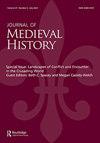十世纪英格兰的helland:翻译、传递与动荡
IF 0.2
2区 历史学
0 MEDIEVAL & RENAISSANCE STUDIES
引用次数: 0
摘要
摘要:《赫连德》是对古撒克逊福音书的改写,反映了古撒克逊人大胆努力,不仅要皈依异教徒,启迪教友,强化正统教义,而且要将古撒克逊方言作为一种值得翻译圣经的语言。这首诗的复制品在10世纪下半叶甚至更早的时候就已经在英国出现了。在现存的一本来自英国的复制品中,在接近写作时,在页边空白处添加了一本福音选集的两个主词,它们揭示了这首诗是如何被查阅的,并可能被用于指导十世纪英国宫廷面临的具体问题。从其起源于关于本土语言在延续父权传统中的能力的神学声明开始,《赫兰德》后来被视为一本澄清如何应对基督教王国面临的敌对军事和精神威胁的文本。本文章由计算机程序翻译,如有差异,请以英文原文为准。
The Heliand in tenth-century England: translation, transmission and turbulence
ABSTRACT The Heliand is a rewriting of the Gospels in Old Saxon, reflecting daring efforts to not only convert pagans, edify catechumens and reinforce orthodox teachings, but also to present the Old Saxon vernacular as a language worthy of translating Scripture. A copy of the poem was in England by the second half of the tenth century, perhaps even earlier. In the single surviving copy from England, two incipits from a gospel lectionary were added in the margins near the time of writing, and they shed much light on how this poem was consulted and probably used for guidance on specific issues faced by a tenth-century English court. From its origin as a theological statement about the capabilities of vernacular languages in continuing Patristic traditions, the Heliand was later valued as a text that offered clarification on how to deal with hostile military and spiritual threats to Christian kingdoms.
求助全文
通过发布文献求助,成功后即可免费获取论文全文。
去求助
来源期刊

JOURNAL OF MEDIEVAL HISTORY
MEDIEVAL & RENAISSANCE STUDIES-
CiteScore
0.60
自引率
0.00%
发文量
29
期刊介绍:
The Journal of Medieval History aims at meeting the need for a major international publication devoted to all aspects of the history of Europe in the Middle Ages. Each issue comprises around four or five articles on European history, including Britain and Ireland, between the fall of Rome and the Renaissance. The Journal also includes review articles, historiographical essays and state of research studies.
 求助内容:
求助内容: 应助结果提醒方式:
应助结果提醒方式:


